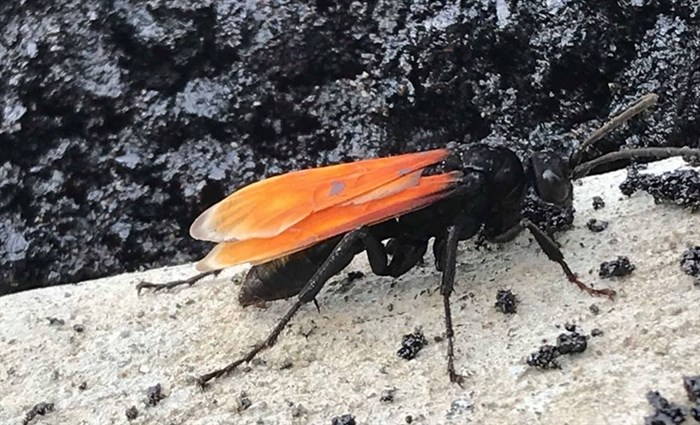
The tarantula hawk is one of the largest species in the spider wasp family. It's common to see the spider-hunting insect throughout the Southern Interior.
Image Credit: FACEBOOK/Tara Pastro
September 20, 2018 - 12:30 PM
People with a fear of spiders will be glad to know there is another insect in the Southern Interior that actually hunts those eight-legged insects
It's called the tarantula hawk, and although the name might sound like it's a cross between a bird and a spider, it's actually one of the largest species of the spider wasp family.
Kamloops resident Tara Pastro turned to Facebook earlier this week to report an insect her husband and son came across in the city.
"So my husband and son saw this today in Kamloops. It is what we believe to be a Tarantula Wasp (Tarantula Hawk). Wikipedia states they have been as far as north as Utah...well we are much further north than that...Has anyone else seen one of these in the B.C. Interior? I'm feeling like it shouldn't be here."
It turns out the spider-hunting wasp is supposed to be here, according to Claudia Copley the entomology collections manager and researcher at the Royal B.C. Museum in Victoria.
"This species is so lovely," Copley says. "I've seen it in the Okanagan a number of times and we have specimens from there as well as Salmon Arm so (seeing it) in Kamloops isn't unlikely."
The tarantula hawk is designed to immobilize a tarantula, she says, and they're about two to three centimeters long with large bright orange wings.
"They can be seen actively hunting and running on the ground, they go into burrows and when they land, they flick their wings," she says.
In general, they sting their prey without killing it.
"They take their prey underground into a burrow and they lay an egg on it so the (tarantula wasp's) larva has some fresh meat to eat while it's developing," she says, adding that the larva will live off the paralyzed spider.
Although they do have painful stings, there's no need to be alarmed, Copley says, they're not out to get humans.
"You would have to be holding onto one for it to sting you," she says. "If you try and grab one it's going to defend itself."
Copley says the insects aren't poisonous and the sting, while painful, shouldn't last long.
For more information on the tarantula hawk go here.
To contact a reporter for this story, email Karen Edwards or call (250) 819-3723 or email the editor. You can also submit photos, videos or news tips to the newsroom and be entered to win a monthly prize draw.
We welcome your comments and opinions on our stories but play nice. We won't censor or delete comments unless they contain off-topic statements or links, unnecessary vulgarity, false facts, spam or obviously fake profiles. If you have any concerns about what you see in comments, email the editor in the link above.
News from © iNFOnews, 2018